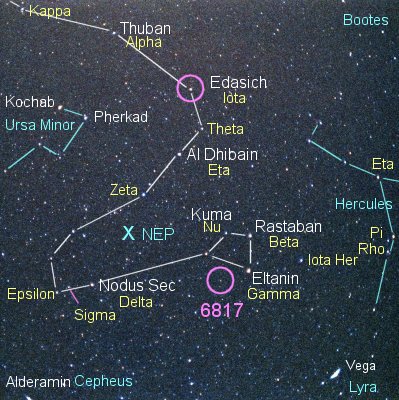 Like Kappa Corona Borealis, HR 6817
(known only by catalogue
numbers) used to be a much hotter class A star, showing that
such stars -- which are more massive than the Sun and frequently
have surrounding debris disks -- also have real planets to go along
with them.
Like Kappa Corona Borealis, HR 6817
(known only by catalogue
numbers) used to be a much hotter class A star, showing that
such stars -- which are more massive than the Sun and frequently
have surrounding debris disks -- also have real planets to go along
with them.
THE PLANET
The lower circle shows the location of the class K giant HR 6817
Draconis (in the constellation Draco).
The planet orbits the star every 416.1 days (1.14 years) in a
nearly circular orbit that averages 1.3 Astronomical Units from the
star, not that much farther than the Earth is from the Sun. Since
we do not know the orbital tilt, we can measure only a lower limit
to the planet's mass, which is at least 1.6 times that of Jupiter.
|
 Like Kappa Corona Borealis, HR 6817
(known only by catalogue
numbers) used to be a much hotter class A star, showing that
such stars -- which are more massive than the Sun and frequently
have surrounding debris disks -- also have real planets to go along
with them.
Like Kappa Corona Borealis, HR 6817
(known only by catalogue
numbers) used to be a much hotter class A star, showing that
such stars -- which are more massive than the Sun and frequently
have surrounding debris disks -- also have real planets to go along
with them.